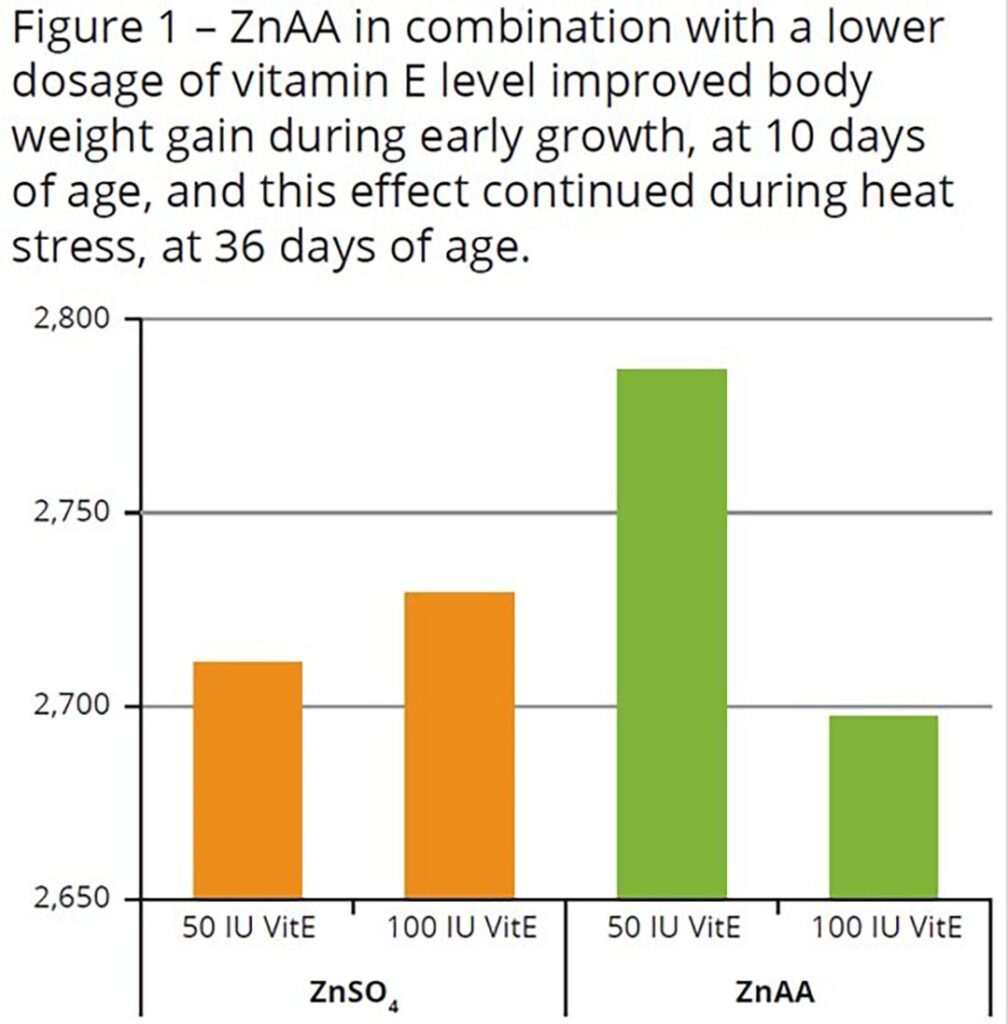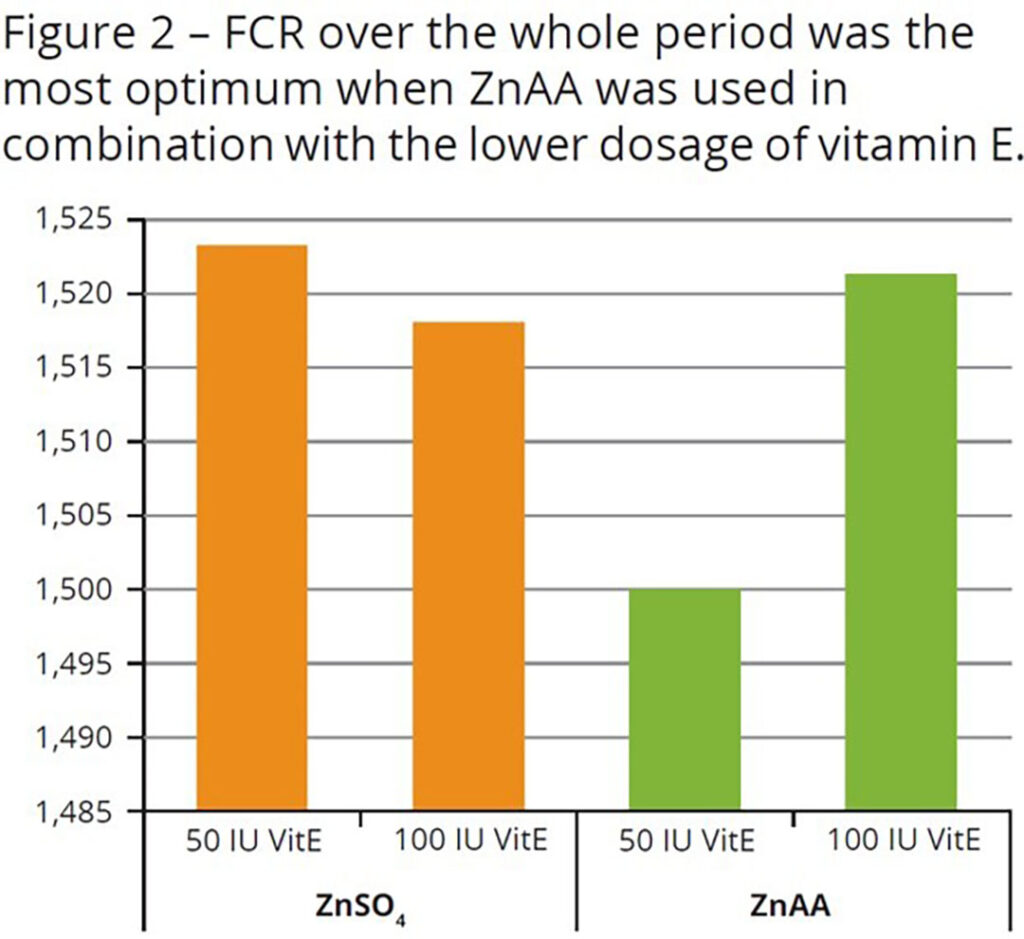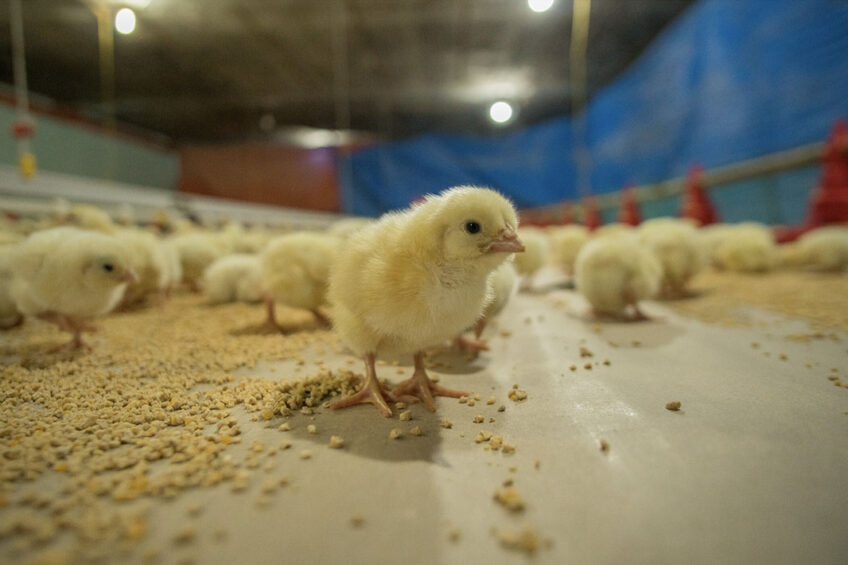Zinc and vitamin E are vital antioxidants that protect the gut and support broiler growth and health during heat stress conditions. The biggest wins are reached by supplying them during the early days post-hatch. Now, research shows that more is not always better.
High feed prices alone are a huge challenge to tackle, but when poultry producers are faced with added challenges, such as heat stress, it puts even more pressure on controlling feed efficiency, animal performance and farm profitability. Gut health plays an important role in making birds more resilient, healthy and on target during all the challenges they face, including heat stress.
The sooner the gut maturation is positively modulated, the bigger wins can be achieved. Early intervention is key because the chick’s gut development is developing fast during early life. In the first 3 days after hatch, the absorptive nutrient area of the intestines increases by 70% (increase of villi length). This is essential because the chick needs to adapt fast from a diet based on lipids (yolk lipids) to a solid carb/protein-based diet. Gut development is complete by 10 days and the mature gut microbiome is established around 17 days.
Zinc and vitamin E
Over the years, the industry has gained a lot more insights on how to determine and measure ‘intestinal health’, and how to positively influence it through nutrition and certain feed additives such as zinc and vitamin E, both of which are vital antioxidants that protect the gut through different modes of actions.
But not all zinc sources available on the market are the same and therefore do not perform the same. The type of zinc used in poultry diets can therefore influence the optimum level of both zinc and vitamin E. Although responses to dietary zinc and vitamin E have been investigated at different environmental temperatures, to the best of our knowledge, interactions of different zinc sources and vitamin E levels have not been investigated under heat stress conditions in broilers.
A study by De Grande et al (2021), published in the Journal of Animal Physiology and Animal Nutrition, considered different levels of vitamin E in combination with different sources of zinc. The trial looked at 2 sources of zinc, 60 mg/kg of zinc as ZnSO4 or 60 mg/kg of zinc as zinc amino acid complexes* (hereafter called ZnAA), combined with 2 levels of vitamin E (50 or 100 IU/kg). Performance was measured from day 0-36. From day 28 until day 36 (finisher period), all birds were subjected to chronic cyclic high temperatures (32°C ± 2°C and relative humidity 55-65% for 6 hours daily).
More is not always better
 One could expect that feeding 100 IU of vitamin E after hatch would be more beneficial than the lower dosage used in this trial (50 IU), considering that during embryonic growth the embryo is consuming all vitamins and trace minerals to support its growth. However, this trial showed that at day 10 of age, the greatest body weight was obtained when ZnAA and 50 IU/kg of vitamin E was used (Figure 1).
One could expect that feeding 100 IU of vitamin E after hatch would be more beneficial than the lower dosage used in this trial (50 IU), considering that during embryonic growth the embryo is consuming all vitamins and trace minerals to support its growth. However, this trial showed that at day 10 of age, the greatest body weight was obtained when ZnAA and 50 IU/kg of vitamin E was used (Figure 1).
This positive result is most probably because of better intestinal development after hatch, with an increase in villi length, leading to better absorption of nutrients. These results have also been confirmed in previous studies and are important as it shows the benefits of modulating the gut at an early stage.
 This positive difference continued up to day 28 when the heat stress model was applied, reflected in a higher daily weight gain and daily feed intake and improved feed conversion ratio (FCR) over the whole period (Figure 2). This effect was not observed at a vitamin E level of 100 IU/kg, confirming the effect that a higher inclusion rate of vitamin E under these circumstances is not needed.
This positive difference continued up to day 28 when the heat stress model was applied, reflected in a higher daily weight gain and daily feed intake and improved feed conversion ratio (FCR) over the whole period (Figure 2). This effect was not observed at a vitamin E level of 100 IU/kg, confirming the effect that a higher inclusion rate of vitamin E under these circumstances is not needed.
Early gut development
Regardless of vitamin E level, birds fed a diet supplemented with ZnAA had a higher villus length and villus length to crypt depth ratio in duodenum sections as compared to birds fed a diet supplemented with ZnSO4 on day 10, 28 and 36. The results seen at day 10 are particularly important because the gut at this stage is still developing. An increase in villus length results in an increase in intestinal surface, which is directly proportional to digestive and absorptive efficiency and thus also to feed conversion efficiency. This might partly explain the positive effects of ZnAA on performance parameters.
An effect of zinc source was also observed for the infiltration of CD3-positive T-lymphocytes in duodenum sections on day 36, with a lower infiltration of CD3-positive T-lymphocytes for birds fed a diet supplemented with ZnAA compared to ZnSO4. A decreased infiltration of CD3-positive T-lymphocytes was already seen at day 10 using ZnAA and indicates a decreased stimulation of the immune system of the intestinal tract.
The study also looked at ovotransferrin, a marker for gut barrier failure in broiler chickens that can be used to assess the efficacy of additives or strategies that reduce intestinal damage. The lower the ovotransferrin level, the less gut health damage. For both vitamin E levels, the use of ZnAA resulted in a lower ovotransferrin concentration in the ileum content (μg/g), compared to ZnSO4 (at day 36). Further data showed that ZnAA also performed better than ZnSO4in increasing breast meat yield by 3.1% and reducing 24-h drip loss by 25%.
Preparing the bird
Performance and resilience against heat stress can be positively influenced via supplementation of zinc as in the form of ZnAA used in this trial, and a vitamin E level of 50 IU/ kg early in life when the gut and its microbiome are being developed. Providing zinc in this form positively influences gut and microbiome development and hence promotes growth, and more importantly, prepares the bird for future challenges such as heat stress. Interestingly, under the conditions of this study, positive effects on performance did not occur when vitamin E was supplemented at 100 IU/kg in feed, providing an economic benefit.
*Zinpro Availa Zn, part of the Zinpro Performance Minerals range.



